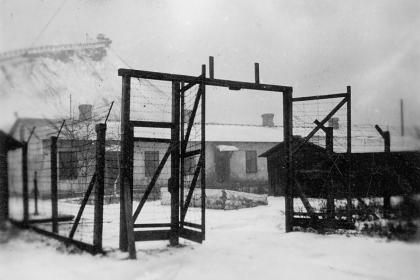Käva prison camp
Before World War II, the Ida-Viru region had become a significant strategic hub for the oil shale industry. Efforts were made to ramp up production starting in 1943, as fuel and lubricants produced here were crucial for the German war economy. The wartime conditions posed a significant challenge in terms of finding a workforce, leading to the use of prisoners. Numerous camps were established in the region for Soviet prisoners of war and Jewish detainees brought in from various countries.
In the spring of 1943, a prisoner camp, Dulag 377, was set up in Kiviõli to supply the oil shale industry with labour. It consisted of five sub-camps: Kohtla, Kütte-Jõu, Ahtme, Kukruse and Käva. With more prisoners brought in from camps elsewhere, an estimated 15,000 to 17,000 Soviet prisoners of war worked in the oil shale industry. Thousands of them perished due to insufficient food, poor living conditions, infectious diseases and the brutality of the camp guards.
By the beginning of the German occupation, around a thousand individuals from the small Estonian Jewish community remained in their homeland; they were annihilated as part of the Holocaust by early 1942. In August 1943, to meet the labour demand of the oil shale industry, a concentration camp was established in Vaivara for Jewish detainees brought in from various countries. Vaivara concentration camp consisted of a network of approximately twenty sub-camps, with most of the nearly 10,000 inmates subjected to forced labour in the Ida-Viru oil shale industry. The majority of Jews brought in during 1943 came from the ghettos of Lithuania and, to a lesser extent, Latvia. In 1944, some also arrived from Hungary. Nearly a third of them died in Estonia due to harsh living conditions or were deemed unfit to work and sent to other camps, where they were subsequently executed.
The camps in Ida-Viru County began closing in 1944 as the front lines shifted. Soviet prisoners of war were sent on foot to Saaremaa and evacuated by sea to Germany. About a third of the Jews from the Vaivara camp were evacuated to Stutthof concentration camp in August 1944, while the rest were executed during the dismantling of the camp system in 1944. During the German retreat, the remaining approximately 2,000 Jews from the Vaivara sub-camps were gathered at Klooga concentration camp, where most of them were murdered on 19 September 1944.
Käva camp was burned, and the mine was flooded during the German forces’ retreat in the autumn of 1944. Upon the return of Soviet occupation authorities, a German prisoner-of-war camp operated here from 1944 to 1950. In 1945, the camp’s inmates began construction of a new mine in Käva. Conditions in the prisoner-of-war camp were no better than those in concentration camps, and many prisoners perished due to the arduous labour and malnutrition. The Soviet Union released German prisoners of war by 1950.
Further Reading:
